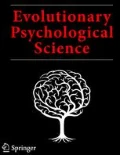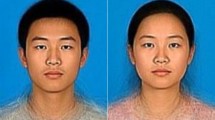Abstract
Unlike women, or men considering long-term mates, men pursuing short-term mating have shown a tendency to prioritize bodily information over facial information when assessing potential mates. Prior studies have documented this tendency across a variety of methods ranging from photograph ratings to forcing a choice between faces and bodies, but have yet to ask participants to prioritize individual traits in faces and bodies. The current study used a budget allocation method to do just that. We randomly assigned participants (N = 258) to a mating context (short-term or long-term) and a budget (high or low) and asked them to allocate points across 10 traits (five facial, five bodily) to design their ideal mate within their budget. As expected, men in the short-term mating context allocated more points to bodily traits, but only when in the low budget condition—in the high budget condition, men showed more interest in facial traits. Women, also as expected, and in contrast to men, showed a general trend toward favoring facial traits regardless of budget and condition. Overall, the results are consistent with the hypothesis that women’s bodies provide better information regarding immediate fertility and are thus more important for men to assess in short-term mating contexts.


Similar content being viewed by others
References
Bleske-Rechek, A., Harris, H. D., Denkinge, K., Webb, R. M., Erickson, L., & Nelson, L. A. (2011). Physical cues of ovulatory status: A failure to replicate enhanced facial attractiveness and reduced waist-to-hip ratio at high fertility. Evolutionary Psychology, 9, 336–353.
Buss, D. M. (1984). Marital assortment for personality dispositions: Assessment with three data sources. Behavior Genetics, 14, 111–123.
Buss, D. M. (1989). Sex differences in human mate preferences: Evolutionary hypotheses tested in 37 cultures. Behavioral and Brain Sciences, 12, 1–49.
Buss, D. M., & Shackelford, T. K. (2008). Attractive women want it all: Good genes, economic investment, parenting proclivities, and emotional commitment. Evolutionary Psychology, 6, 134–146.
Cloud, J. M., & Perilloux, C. (2014). Bodily attractiveness as a window to women's fertility and reproductive value. In V. A. Weekes-Shackelford & T. Shackelford (Eds.), Evolutionary Perspectives on Human Sexual Psychology and Behavior (pp. 135–152). Oxford: Oxford University Press.
Cloud, J. M., & Perilloux, C. (2015). “Drawing” conclusions about perceptions of ideal male and female body shapes. Evolutionary Psychological Science, 1, 163–171.
Confer, J. C., Perilloux, C., & Buss, D. M. (2010). More than just a pretty face: Men’s priority shifts toward bodily attractiveness in short-term versus long-term mating contexts. Evolution and Human Behavior, 31, 348–353.
Currie, T. E., & Little, A. C. (2009). The relative importance of the face and body in judgments of human physical attractiveness. Evolution and Human Behavior, 30, 409–416.
Fales, M. R., Frederick, D. A., Garcia, J. R., Gildersleeve, K. A., Haselton, M. G., & Fisher, H. E. (2016). Mating markets and bargaining hands: Mate preferences for attractiveness and resources in two national US studies. Personality and Individual Differences, 88, 78–87. https://doi.org/10.1016/j.paid.2015.08.041.
Fink, B., Neave, N., & Seydel, H. (2007). Male facial appearance signals physical strength to women. American Journal of Human Biology, 19(1), 82–87.
Folstad, I., & Karter, A. J. (1992). Parasites, bright males, and the immunocompetence handicap. The American Naturalist, 139, 603–622.
Gangestad, S. W., Thornhill, R., & Yeo, R. A. (1994). Facial attractiveness, developmental stability, and fluctuating asymmetry. Ethology and Sociobiology, 15, 73–85.
Jonason, P. K., Raulston, T., & Rotolo, A. (2012). More than just a pretty face and a hot body: Multiple cues in mate choice. The Journal of Social Psychology, 152, 174–184.
Kirchengast, S., & Gartner, M. (2002). Changes in fat distribution (WHR) and body weight across the menstrual cycle. Collegium Antropologicum, 26, 47–57.
Little, A. C., Třebický, V., Havlíček, J., Roberts, S. C., & Kleisner, K. (2015). Human perception of fighting ability: Facial cues predict winners and losers in mixed martial arts fights. Behavioral Ecology, 26(6), 1470–1475.
Lu, H. J., & Chang, L. (2012). Automatic attention towards face or body as a function of mating motivation. Evolutionary Psychology, 10, 120–135.
Luo, S. (2017). Assortative mating and couple similarity: Patterns, mechanisms, and consequences. Social and Personality Psychology Compass, 11(8), 1–14. https://doi.org/10.1111/spc3.12337.
Mogilski, J. K., & Welling, L. L. M. (2017). The relative importance of sexual dimorphism, fluctuating asymmetry, and color cues to health during evaluation of potential partners’ facial photographs: A conjoint analysis study. Human Nature, 28(1), 53–75. https://doi.org/10.1007/s12110-016-9277-4.
Mogilski, J. K., & Welling, L. L. M. (2018). The relative contribution of jawbone and cheekbone prominence, eyebrow thickness, eye size, and face length to evaluations of facial masculinity and attractiveness: A conjoint data-driven approach. Frontiers in Psychology, 9. https://doi.org/10.3389/fpsyg.2018.02428.
Mueser, K. T., Grau, B. W., Sussman, S., & Rosen, A. J. (1984). You’re only as pretty as you feel: Facial expression as a determinant of physical attractiveness. Journal of Personality and Social Psychology, 46, 469–478.
Penke, L., & Asendorpf, J. B. (2008). Beyond global sociosexual orientations: A more differentiated look at sociosexuality and its effects on courtship and romantic relationships. Journal of Personality and Social Psychology, 95, 1113–1135.
Perilloux, C., Cloud, J. M., & Buss, D. M. (2013). Women’s physical attractiveness and short-term mating strategies. Personality and Individual Differences, 54, 490–495.
Puts, D. A., Bailey, D. H., Cárdenas, R. A., Burriss, R. P., Welling, L. L., Wheatley, J. R., & Dawood, K. (2013). Women’s attractiveness changes with estradiol and progesterone across the ovulatory cycle. Hormones and Behavior, 63, 13–19.
Roberts, S. C., Havlicek, J., Flegr, J., Hruskova, M., Little, A. C., Jones, B. C., et al. (2004). Female facial attractiveness increases during the fertile phase of the menstrual cycle. Proceedings of the Royal Society of London, 271, S270–S272.
Sell, A., Cosmides, L., Tooby, J., Sznycer, D., von Rueden, C., & Guryen, M. (2009). Human adaptations for the visual assessment of strength and fighting ability from the body and face. Proceedings of the Royal Society B: Biological Sciences, 276(1656), 575–584. https://doi.org/10.1098/rspb.2008.1177.
Singh, D. (1993). Adaptive significance of female physical attractiveness: Role of waist-to-hip ratio. Journal of Personality and Social Psychology, 65, 293–307.
Sugiyama, L. S. (2005). Physical attractiveness in adaptationist perspective. In D. M. Buss (Ed.), The handbook of evolutionary psychology (pp. 292–343). Hoboken, NJ: Wiley.
Symons, D. (1979). The evolution of human sexuality. New York: Oxford University Press.
Thiessen, D., & Gregg, B. (1980). Human assortative mating and genetic equilibrium: An evolutionary perspective. Ethology and Sociobiology, 1, 111–140.
Thornhill, R., & Gangestad, S. W. (1993). Human facial beauty: Averageness, symmetry, and parasite resistance. Human Nature, 4, 237–269.
Thornhill, R., & Grammer, K. (1999). The body and face of woman: One ornament that signals quality? Evolution and Human Behavior, 20, 105–120.
Zilioli, S., Sell, A. N., Stirrat, M., Jagore, J., Vickerman, W., & Watson, N. V. (2015). Face of a fighter: Bizygomatic width as a cue of formidability. Aggressive Behavior, 41(4), 322–330. https://doi.org/10.1002/ab.21544.
Acknowledgements
We would like to thank Gregory Webster for statistical advice and Taylar Boyer, Kaylee DeBolt, Jacob Dougherty, Aliehs Lee, Helena Lorenz, Cody Welty, and Justin White for their assistance with pilot-testing and data collection.
Author information
Authors and Affiliations
Corresponding author
Ethics declarations
Conflict of Interest
The authors declare that they have no conflict of interest.
Additional information
Publisher’s Note
Springer Nature remains neutral with regard to jurisdictional claims in published maps and institutional affiliations.
Rights and permissions
About this article
Cite this article
Perilloux, C., Cloud, J.M. Mate-by-Numbers: Budget, Mating Context, and Sex Predict Preferences for Facial and Bodily Traits. Evolutionary Psychological Science 5, 294–299 (2019). https://doi.org/10.1007/s40806-019-00187-z
Published:
Issue Date:
DOI: https://doi.org/10.1007/s40806-019-00187-z




